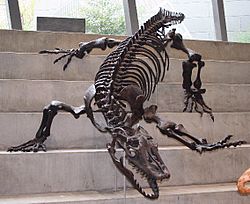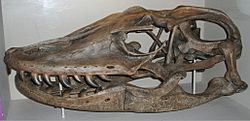Megalania facts for kids
Quick facts for kids MegalaniaTemporal range: Late Pleistocene
|
|
|---|---|
 |
|
| Megalania skeletal reconstruction on Melbourne Museum steps | |
| Scientific classification | |
| Kingdom: | |
| Class: | |
| Order: | |
| Family: | |
| Genus: |
Varanus
|
| Binomial name | |
| Varanus priscus Owen 1859
|
|
Megalania (scientific name: Varanus priscus) was a super-sized monitor lizard that lived in Australia a very long time ago, during a period called the Pleistocene epoch. It was the biggest land lizard ever known! Imagine a monitor lizard, like the ones you might see in zoos or nature documentaries, but much, much larger – like, car-sized or even bigger! Because scientists only have pieces of its skeleton, figuring out its exact size is a bit tricky, but they agree it was truly enormous.
Let's dive deeper into what scientists have learned about this incredible reptile from the clues left behind in fossils.
Contents
Naming and Classification
The first time scientists officially learned about Megalania was in 1859. A famous scientist named Sir Richard Owen studied some fossil bones, mostly backbones (vertebrae), that were found near a river in eastern Australia.
Sir Richard Owen gave it the name Megalania prisca. He chose this name because he thought it meant "ancient great roamer," referring to it being a large, old lizard that walked on land. The word "Megalania" comes from a Greek word meaning "I roam."
Interestingly, the Greek word sounds a lot like the Latin word for "butcher." This has sometimes led people to mistakenly think the name means "ancient giant butcher," but the original meaning intended was about its roaming nature.
When scientists first found Megalania, they thought it was so different and so big that it needed its own special group, or genus, called Megalania. However, as they found more fossils and learned more about lizards, they realized that Megalania was actually very closely related to the monitor lizards that are alive today, all of which belong to the genus Varanus.
Today, most scientists agree that Megalania should be included in the Varanus genus, just like the Komodo dragon, the perentie, and other monitor lizards. Its scientific name is now usually Varanus priscus. This change happened because its body structure shows it's more closely related to some Varanus species than others. If it wasn't in the Varanus group, that group wouldn't make sense scientifically because it would leave out a very close relative.
Even though the official scientific genus name is now Varanus, many people, including scientists in less formal settings, still use "Megalania" as a common or "vernacular" name for Varanus priscus. It's a name that has stuck because of its history and how impressive the animal was!
How Big Was It? The Giant Debate
One of the biggest challenges in understanding Megalania is that scientists haven't found a complete skeleton. Most of the fossils are just pieces – bones from the back, legs, skull, or jaw. This makes figuring out the exact size of a full-grown Megalania a bit like trying to guess the size of a whole puzzle when you only have a few pieces!
When Megalania was first discovered, some scientists thought the biggest ones could have been as long as 7 meters (about 23 feet) and weighed around 600–620 kilograms (about 1,320–1,370 pounds). To give you an idea, 7 meters is longer than a standard school bus!
Later, in 2002, a scientist named Stephen Wroe looked at the fossils again and suggested that the earlier estimates might have been too big. He thought the maximum length was probably closer to 4.5 meters (about 15 feet) and the weight around 331 kilograms (about 730 pounds). He suggested that average Megalania might have been around 3.45 meters (about 11.3 feet) long and weighed between 97 and 158 kilograms (about 214–348 pounds).
However, just a few years later, in 2009, Stephen Wroe and other scientists revised their estimates upwards again, suggesting that large individuals could have reached at least 5.5 meters (about 18 feet) long and weighed around 575 kilograms (about 1,268 pounds).
Scientists have used different methods to estimate size. Some have looked at the width of the backbones and compared them to living monitor lizards to guess the length from the snout to the base of the tail (called snout-vent length). Using this method, some average Megalania might have had a snout-vent length of 2.2–2.4 meters (about 7.2–7.9 feet) and weighed up to 320 kilograms (about 710 pounds). One very large backbone suggested an individual with a snout-vent length of 3.8 meters (about 12 feet) and a massive weight of up to 1,940 kilograms (about 4,280 pounds)! That's heavier than a small car!
Another way scientists estimate size is by comparing the known Megalania fossils to the bones of all the different kinds of monitor lizards alive today. By scaling up from the fossils based on these comparisons, they've estimated snout-vent lengths for known specimens ranging from about 1.78 to 2.17 meters (about 5.8 to 7.1 feet). They also noted that since the biggest living monitor lizards are much larger than average individuals of their species, it's possible that some Megalania could have grown to be over 3 meters (about 9.8 feet) just in snout-vent length, meaning their total length with the tail would be much greater.
So, while the exact maximum size is still debated because of the incomplete fossils, scientists agree that Megalania was incredibly large. Even the more conservative estimates make it the biggest land lizard ever known, with the largest individuals likely reaching lengths of 5 meters (about 16 feet) or more and weighing hundreds, possibly even over a thousand, kilograms.
What Was Megalania Like?
Megalania had a strong, heavy body and powerful legs. Its skull was large, and it even had a small ridge between its eyes. Its mouth was filled with serrated, blade-like teeth, perfect for cutting into prey.
While Megalania was huge, some scientists wonder if it was the only or even the main predator of the giant Australian megafauna. They point out that another ancient Australian animal, the marsupial lion (Thylacoleo carnifex), which was a powerful meat-eating marsupial, has been linked to hunting very large mammals, while Megalania fossils aren't as often found with evidence of this kind of hunting. Also, Megalania fossils are quite rare compared to the marsupial lion's fossils, which are found in many places across Australia. Another giant predator from that time was Quinkana, a type of land-dwelling crocodile that could grow up to 6 meters long! So, ancient Australia had several fearsome hunters.
Diet
As the largest land lizard, Megalania was almost certainly a top predator in its environment. It would have hunted and eaten other animals. Scientists think it probably ate medium to large animals. This could have included some of the other giant animals living in Australia at the time, like the massive plant-eating marsupial Diprotodon. It might have also preyed on other reptiles, smaller mammals, birds, and their eggs.
How fast could this giant lizard move?
Based on studies comparing it to living lizards and using some of the earlier size estimates, scientists think Megalania might have been able to sprint at speeds of about 2.6–3 meters per second (about 9.4–10.8 kilometers per hour). This is roughly as fast as a freshwater crocodile can move on land.
Scales
Like modern monitor lizards, Megalania likely had tough scales covering its body. These scales probably had a special structure that made them strong and helped prevent the lizard from losing too much water, which would be important in the Australian climate.
Did Megalania Have Venom?
Interestingly, some of Megalania's closest living relatives, like the Komodo dragon and the Nile monitor, have venom glands in their mouths. Scientists group these lizards, along with snakes and some other reptiles, into a larger group called Toxicofera, which includes animals that have or are closely related to those with toxin-secreting glands.
The venom in these related lizards is a type called a haemotoxin. This means it affects the blood. It can act like an anticoagulant, making it harder for the prey's blood to clot. This would cause the prey to bleed more heavily from bites, leading to a drop in blood pressure and potentially causing the animal to go into shock.
Because Megalania is part of this group and is closely related to venomous lizards, some scientists think it's possible that Megalania was also venomous. If it was, it would be the largest venomous animal known to have ever lived! This would have made it an even more formidable predator.
The End of the Giant Lizard: Extinction
The youngest fossils of Megalania that scientists have found date to around 50,000 years ago. This means that by about 50,000 years ago, Megalania was likely no longer roaming Australia. Around the same time that Megalania and many other large Australian megafauna disappeared, the first Aboriginal people arrived in Australia. This timing has led scientists to consider whether the arrival of humans played a role in the extinction of these giant animals.
Scientists think there could be a few reasons why Megalania went extinct, possibly a combination of factors:
- Early humans were skilled hunters. It's possible they hunted Megalania, or perhaps they hunted the large animals that Megalania relied on for food, making it harder for the giant lizards to survive.
- Humans might have also competed with Megalania for resources, or changed the environment in ways that made it difficult for the giant lizard to thrive.
- While the arrival of humans seems to line up with the extinction, changes in climate or environment could have also played a role, although the human impact is often considered a major factor for the megafauna extinctions around this time.
Images for kids
See also
 In Spanish: Megalania para niños
In Spanish: Megalania para niños



